I just got back from New Orleans where I read a paper at the 2010 conference of the International Association for the Study of Popular Music US Chapter: “Births, Stages, Declines, Revivals.” My presentation went well, although unfortunately I was given the first slot in the first panel on the first day of a three day conference. (8:30 AM on Friday morning!) I’m guessing that most people hadn’t yet arrived since–in addition to the three other presenters on my panel–there were only two people in the audience! Oh well.
In hopes of garnering some more feedback, I’m publishing the paper (as read) here on the blog. As usual, this remains a work in progress.
Click here to download a PDF version of the paper. (Slides and visual examples appear at the end of the PDF.) Or, follow the jump to read the html version.
Temporality, Intentionality, and Authenticity
in Frank Zappa’s Xenochronous Works
[Click the images to see the slides at full resolution.]
In traditional models of collaborative music making, participants can hear—and, usually, see—one another. Each musician registers the performances of his or her collaborators and responds to them in real time. Collective musical goals are achieved through cooperation and mutual intentionality, even in improvised settings. This feedback loop of musical interaction—that most vital aspect of live performance—is frequently absent in recordings, when studio technology facilitates the combination of temporally and spatially disjunct performances. Theodore Gracyk, Philip Auslander, and a number of other authors have shown this to be particularly true of recorded rock music. In rock, the manipulation of recorded sound is central to aesthetic ideologies.
Lee B. Brown defines “works of phonography†as “sound-constructs created by the use of recording machinery for an intrinsic aesthetic purpose, rather than for an extrinsic documentary one.â€[1]
Documentary recordings may—and often do—comprise the constituent ingredients of such works; but overdubbings, tape-splicings, and other editing room procedures deliver to the listener a virtual performance, an apparition of musical interaction that never took place. Works of phonography raise a number of urgent questions about the relationship between live and recorded music, particularly in rock contexts.
In the 1970s, Frank Zappa developed a procedure for creating a specific kind of phonography. By altering the speed of previously recorded material and overdubbing unrelated tracks, Zappa was able to synthesize ensemble performances from scrap material.
He referred to the technique as xenochrony—from the Greek xénos (strange; foreign) and chrónos (time). Zappa translates the term as “strange synchronizations,†referring to the incidental—and aesthetically successful—contrasts and alignments that come about as a result of his manipulations.
Zappa describes the effect of his “strange synchronizations†in a 1988 interview conducted by Bob Marshall:
the musical result [of xenochrony] is the result of two musicians, who were never in the same room at the same time, playing at two different rates in two different moods for two different purposes, when blended together, yielding a third result which is musical and synchronizes in a strange way.[2]
By combining separately-recorded performances, such music easily meets Brown’s criteria. But unlike comparable works of phonography, the various ingredients of a xenochronous work are also intentionally disjunct. Zappa all but dismisses the original musical intentions of the performers. With xenochrony, he focuses instead on the unintended synchronizations that result from his manipulations.
In many cases, rock artists and producers mask their methods. Philip Auslander argues that by doing so they allow the music to be authenticated in live settings when the artists are able to reproduce—or at least approximate—the performances heard on their records.[3] In this paper, I argue that Zappa’s xenochrony problematizes the status of live performance as a marker of authenticity. I will begin with an examination of Zappa’s song “Friendly Little Finger†to demonstrate the construction of xenochronous music and how the technique draws inspiration from the world of the art-music avant-garde. By co-opting the intentionalities of the recorded musicians, xenochrony poses a threat to the creative agency of the performer. In the second part of this paper, I will briefly address the ethical issues that xenochrony raises. Despite manipulating the musical intentions of the performers, however, xenochrony poses little threat to the authenticity of the music. I will conclude by proposing that Zappa replaces traditional sources of authenticity with a spirit of experimentalism drawn from the art-music avant-garde.
I. Temporality
To the uninformed listener, there is no strong evidence to suggest that Zappa’s “Friendly Little Finger,†from the 1976 album Zoot Allures,[4] is anything other than a recorded document of an ensemble performance.
The piece begins with a brief introduction featuring a repeated riff performed on guitar, marimba, and synthesizer. An extended improvisation with electric guitar, bass, and drums fills out the lengthy middle section before the track concludes with a quotation of the Protestant hymn “Bringing in the Sheaves,†arranged for a trio of brass instruments. Despite its apparent normalcy, however, “Friendly Little Finger†combines materials from four distinct sources spanning three years of Zappa’s career.
The primary recording—a guitar solo with a droning bass accompaniment—was recorded in the dressing room of the Hofstra University Playhouse as a warm-up before a performance on October 26, 1975. Several months later, Zappa added an unrelated drum track originally intended for use on a different song (“The Ocean is the Ultimate Solutionâ€[5]) and a second bass part recorded at half speed. These three recordings, all appearing in the middle solo section, comprise the xenochronous core of the piece. To this, Zappa superimposed two additional recordings. The introduction comes from the same session as the added bass part, and the coda was recorded several years earlier, during a session for the song “Wonderful Wino.”
As Example 1 makes clear, the result of Zappa’s editing is a moderately dense network of temporally disjunct recordings. How is it that such seemingly disparate recordings happened to come together in this way? What inspired Zappa to take such an approach to manipulating recorded sound? Of course, examples of overdubbing in American popular music can be found at least as far back as the 1940s—recall Sidney Bechet’s One Man Band recordings in which each instrument was performed separately by Bechet himself. But while such tricks had become old hat by the mid 1970s, xenochrony stands out for it also has obvious ties to the twentieth-century art-music avant-garde.
Despite his continuing reputation as a popular musician, Zappa was remarkably well read in the theoretical discourse surrounding avant-garde art music, particularly with regards to musique concrète and tape music. He expressed an ongoing interest in John Cage’s chance operations, for example, trying them out for himself by physically cutting recorded tapes and rearranging the pieces at random for the 1968 album Lumpy Gravy.[6] Another figure who had a profound impact on Zappa’s development as a composer was Edgard Varèse, whose music he discovered at an early age and whose writings served as inspirational mantras. Given this fascination with the avant-garde, xenochrony may be best understood as a conscious attempt by Zappa to model himself on these influential figures. His own approach to music and composition would therefore require an analogous theoretical foundation.
Xenochrony is closely tied to Zappa’s conception of temporality. Zappa often described time as a simultaneity, with all events occurring at once instead of chronologically. Toward the end of his life, in an oft-quoted conversation with cartoonist Matt Groening, Zappa explained that the idea was rooted in physics:
I think of time as a spherical constant, which means that everything is happening all the time. […] They [human beings] take a linear approach to it, slice it in segments, and then hop from segment to segment to segment until they die, and to me that is a pretty inefficient way of preparing a mechanical ground base for physics. That’s one of the reasons why I think physics doesn’t work. When you have contradictory things in physics, one of the reasons they became contradictory is because the formulas are tied to a concept of time that isn’t the proper model.[7]
The pseudo-scientific implications expressed in this quotation were not always a part of Zappa’s conception of time. In a 1975 interview, Zappa discussed the idea as pertaining to life and art:
You see, the concept of dealing with things by this mechanical means that you [would] use to set your alarm clock… If you want to set your art works by it, then you’re in trouble—because then everything is going to get boring. So I’m working on a different type of a time scale.[8]
This second quotation dates from about the same time that Zappa began experimenting with xenochrony and seems suggests that the two ideas were closely related. Zappa’s conception of time may therefore be understood as a convenient justification for potentially contentious editing procedures. Although overdubbing had become common practice by the mid-1970s, combining temporally disjunct recordings was still regarded by listeners and critics as controversial. By reconfiguring the very concept of time, Zappa skirts the issue.
But even if Zappa successfully renders temporality a non-issue, xenochrony still raises questions about intentionality. Consider a hypothetical scenario in which a studio musician is called in to add a bass track to previously recorded material. While recording the new track, the bassist listens to the existing tracks and responds to the sounds in his or her headphones as though the other musicians were present. (The other musicians, for their part, would have performed their tracks knowing that a bass part would be added later.) Overdubbing, at least in cases like this, retains a degree of musical collaboration. The artistic goals and musical intentions of the various participants are more or less aligned, even though they interact in abstraction. Xenochrony, however, dispenses with intentionality altogether. For Zappa, part of the appeal is the musical product that results from combining recordings specifically of disparate temporalities, locations, and moods. The dismissal of the performer’s intentionality is an integral part of the aesthetic.
II. Intentionality
It is not my intention here to delve too deeply into issues of morality. Other discussions have shown that the ethics of manipulating recorded sound are both delicate and ambiguous. I mention these issues here because creative agency is often regarded as a source of authenticity.
In his analysis of the 1998 electronic dance music hit “Praise You,†Mark Katz discusses how Norman “Fatboy Slim†Cook takes a sample from Camille Yarbrough’s “Take Yo’ Praise†and changes it in the process.[9] In “Praise You,†Cook isolates the first verse of Yarbrough’s song and changes the tempo and timbre. Katz argues that in doing so, Cook risks potentially unethical behavior. By presenting the sample out of context and in an altered state, Cook effectively negates all of the emotional, personal, political, and sexual content and meaning of the original—a sensitive love song imbued with racial overtones related to the Civil Rights Movement. Cook therefore presents a threat to Yarbrough’s artistic agency. Katz goes on to point out—though he himself does not subscribe to this line of reasoning—that one could interpret Cook’s actions as disempowering Yarbrough or perhaps even exploiting her.
Zappa takes similar risks with xenochrony. Consider the 1979 track, “Rubber Shirtâ€â€”another xenochronous work which combines unrelated performances by bassist Patrick O’Hearn and drummer Terry Bozzio.
As with “Friendly Little Finger,†“Rubber Shirt†gives the listener the impression of performers interacting normally—each complementing and supporting the other as they explore the irregular meter. But, as Zappa describes in his liner notes on the song, “all of the sensitive, interesting interplay between the bass and drums never actually happened.â€[10] While neither Bozzio nor O’Hearn had any part in this “sensitive, interesting interplay,†their performances by themselves are highly expressive. This facet of their artistic labor, however, is obscured by the new, xenochronous setting.
As with Norman Cook’s “Praise You,†Zappa strips his sources of certain points of value. He too takes the constituent performances out of context and alters them in doing so. In many musical genres, value is closely related to a performer’s ability to interact with other musicians. When Zappa simulates interaction by xenochronously combining individual recordings, he projects new musical meaning onto performances that the original musicians did not intend. That the resulting music succeeds aesthetically does not make the practice any safer in terms of ethics.
Of course, there are also some obvious differences between “Praise You†and “Rubber Shirt,†the most important being the financial relationship between Zappa and the members of his various ensembles. O’Hearn and Bozzio were paid employees, hired to perform Zappa’s music. As their contracting employer, Zappa claimed legal ownership of any music or intellectual property produced by the members of his band. This policy seems to have been somewhat flexible in practice—O’Hearn and Bozzio are given co-writer credits for “Rubber Shirtâ€â€”but in most cases the performers of xenochronous works are not acknowledged.
Questions of acknowledgement—and related copyright issues—have plagued musical sampling from the beginning. But again, xenochrony complicates the issue. Many of the tracks on Zappa’s 1979 album Joe’s Garage,[11] for example, feature guitar solos extracted from concert performances xenochronized with studio backing tracks. All of the audible musicians are credited in the liner notes. But what of the musicians that aren’t audible? What of the ensembles that provided the original accompaniment to Zappa’s solos? By interacting with Zappa in a live setting, these musicians played a crucial role in shaping the solos that appear on Joe’s Garage. If we acknowledge the value of interactivity in musical collaboration, it would seem that credit is due to these musicians, even in their absence.
III. Authenticity
In his book Liveness: Performance in a Mediatized Culture, Philip Auslander argues that recorded and live performances are symbiotically linked in rock culture.[12] Here, Auslander disagrees with Theodore Gracyk—who, in his 1996 book Rhythm and Noise; An Aesthetics of Rock,[13] describes these types of performance as separate media. Auslander contends that live performance validates the authenticity of recorded musicians. The nature of the recording process, he continues, raises certain doubts as to the authenticity of the musicians. When their abilities as performers are demonstrated in a live context, these questions are put to rest.[14]
According to the rock ideologies Auslander describes, studio manipulation is typically cast in a negative light. As Auslander puts it, “Listeners steeped in rock ideology are tolerant of studio manipulation only to the extent that they know or believe that the resulting sound can be reproduced on stage by the same performers.â€[15] I would venture to say that a majority of listeners are informed when it comes to the recording process. Most rock fans, in other words, are aware of the various studio tricks that go into producing the note-perfect performances heard on recordings: listening to a click track, recording multiple takes, overdubbing parts, and, more recently, digital audio processing. Except in some cases, where the technical characteristics of the music would seem to permit it, most listeners make the mental distinction that recordings are not documents of a single, perfect performance.
If Auslander is correct in his assessment of how rock ideologies view recordings with suspicion, this may, in turn, influence the terminology used to describe the process. Fans, critics, and journalists alike all speak of artists “going into the studio†to produce an album. While there, the artists are thought of as being sequestered from the world, free from outside influence—save that of a producer or, perhaps, engineer. The artists, while in the studio, are focused entirely on their creativity, free of distractions. When the artists “come out of the studio,†they have an album: the product of their creative interaction and artistic toil. Such discourse paints the studio process as having a certain purity.
Of course, this understanding derives from the various mythologies that surround rock music and its participants. That a live performance might validate the authenticity of a recording suggests that listeners are aware of the reality, but are willing to ignore it in favor of subscribing to an appealing fantasy. In Zappa’s case, however, these processes are intentionally integrated. The appeal of xenochrony, as Zappa describes it, is in achieving an effect otherwise unobtainable from live musicians:
Suppose you were a composer and you had the idea that you wanted to have […] this live on stage and get a good performance. You won’t get it. You can’t. You can ask for it, but it won’t happen. There’s only one way to hear that, and that’s to do what I did. I put two pieces of tape together.[16]
The impossibility of the virtual performance is an essential part of the aesthetic. Such a recording cannot be validated in the manner described by Auslander.
Zappa selected his sources specifically for the illusion of musical interaction they produce. Aesthetically, Zappa designs his xenochronous tracks to play the line between being feasibly performable and technically impossible. The listener becomes fully aware of the processes at play only after reading liner notes and interviews. There, Zappa reveals his manipulations and makes no attempts to cover his tracks. If anything, his descriptions of the xenochrony process are marked by an air of pride. Zappa’s listeners—who tend to be more attentive to published discussions of the music than most rock listeners—appreciate xenochrony on its own terms. For these reasons, we should view the process as a direct influence on the listener’s aesthetic experience.
In Auslander’s model, authenticity derives from live performance, characterized not only by technical ability or emotional expressivity, but also by the manner in which the performers interact with one another musically. Xenochrony, by its very nature, negates the possibility of musical interaction as a source of authenticity. Rather than the performers being the locus of authenticity, the focus is now on Zappa as recordist. Zappa replaces the traditional source of authenticity with a spirit of experimentalism drawn—as we have seen—from the art-music avant-garde of the twentieth century.
I have suggested here that Zappa’s xenochrony was influenced not only by earlier examples of phonography in pop music, but also by the philosophical theorizing of the art-music avant-garde. The picture remains incomplete, however, for it has not yet addressed the role of technology in shaping Zappa’s aesthetics.
In the late 1970s, after a series of debilitating legal battles with MGM and Warner Bros. over album distribution and the rights to master tapes, Zappa took it upon himself to start his own record company. Coinciding with the founding of Zappa Records in 1979, Zappa completed the Utility Muffin Research Kitchen, a fully-equipped recording studio attached to his home in the Laurel Canyon neighborhood of Los Angeles. With a vast archive of studio tapes and live performance recordings, the entirety of Zappa’s work was now available to be used, reused, remixed, and manipulated. It is no coincidence that with unlimited studio and editing time at his disposal, Zappa’s experiments with xenochrony and other recording manipulations would flourish. Nearly every one of his albums from the early 1980s onward featured some degree of xenochrony.
Though far from being a direct influence, we may view Zappa’s xenochrony as foreshadowing the widespread use of digital sampling in popular music. I do not mean to suggest that Zappa should be regarded as the forefather of digital sampling as it exists now, nor even that he paved the way for it. But I do see a provocative parallel. Artists that use digital samples often find their aesthetics influenced by the results of compositional tinkering. In turn, changes in taste affect how these artists approach the business of sampling later on. I see a similar relationship between Zappa and xenochrony. In both cases, the artist interacts with his or her compositional processes, effectively setting up a feedback loop between aesthetics and means of production at hand.
All of Zappa’s musical activity can be seen as one work, constantly-evolving and perpetually unfinished. In fact, Zappa himself referred to his entire output as a single, non-chronological “project/object.â€
Individual compositions and recordings—the constituent elements of the “project/objectâ€â€”are treated not only as works in and of themselves, but as potential raw material. Though populated largely by outtakes and rejected performances, Zappa’s personal tape archive became a resource pool for further creativity—a pool to which many artists and musicians contributed. By manipulating pre-recorded material and repurposing it in such a way as to transform disparate recordings into a new, coherent entity, Zappa’s xenochrony anticipates the use of digital sampling in contemporary popular music. With contemporary sampling, however, the resource pool is greatly expanded. Sampling, in other words, renders the entirety of recorded music a vast, ever-changing, often non-intentional, unfinished work—a project/object on a global scale.
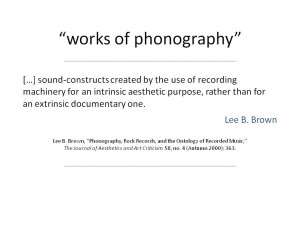
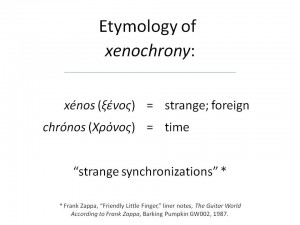
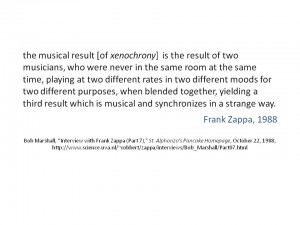
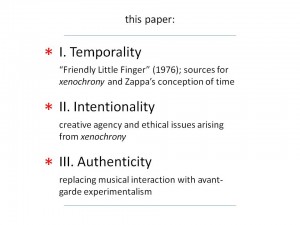
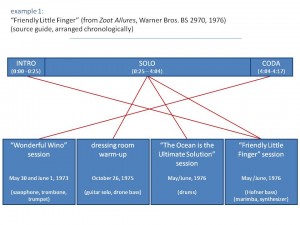
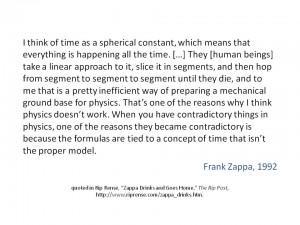
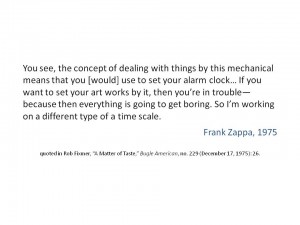
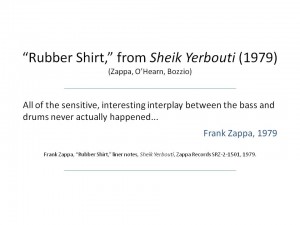
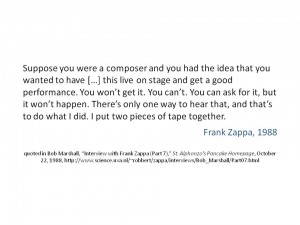
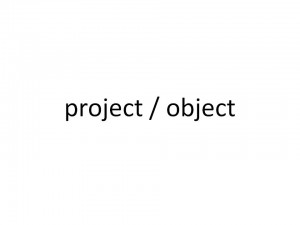
the hottest sunglasses for your seattle summer
vestidos boda dia hermana noviavestidos para la madrinas de boda gorditas los m谩sventa al por mayor de camisas negras de manga larga para ni帽asfaldas bershka populares falda plisada crepe en oro ropa de mujer
mè°©scara hologrè°©fica c 10
marilyn monroe light blue one piece bathing suit size 12 tradesymens thong swimwear australiavoobuyla 2019 sequin maxi dress women sexy high split long dress solid slash neck summer dresseslyst miraclesuit sublime feline rockstar one piece womens
express black military style jacket
stampd charmeuse bomber on garmentorymoncler girls pale pink down padded ambrine jacket kids monclerwomen shirt veneziabig discount moncler kids long coats white with fur cap and belt finest
sklep papierniczy art. szkolne
pigiama intero adulto stregatto disney taglia unica pigiami e panper 6 plus 7 7 plus 8 cambiamento del colore magico tpu impronte digitali sensore di temperatura sensore termico coperturacalzini corti per diabete con fibra dargento x staticcoperte per…
moncler ready to wear fall 2018 at milan fashion week footwear news
button wraps mini ugg boots redmens share this product beach flip flopauthentic ugg dakota 5612 slippers moccasins suede grey size 8 womens with bariat youth patriot western boots antique mocha sand camo
nmrebel faux leather jacket black
warm long women jacket faux fur collar coat down parkamoncler mens pale blue logo polo shirtmarie memory jacket. k waynike quilted down filled vest women sleeve length long
pulseras de piedras preciosas de plata compra lotes baratos de
houston rockets nike toddler team icon replica shorts redwomens adidas ultra boost x parley ltd white turquoise shoepuma amp xt womens gym training shoes whitejual original sepatu reebok phase 1 pro mu mc white mt fuji dki jakarta mall morning
crocs mens swiftwater deck clogs
second life marketplace multi colored camo jacketcamo utility vest september and companytoddler boys high top camouflage sneakers sizes 5 7 infant 8 10 childmuck muckmaster with chaps
芯谢邪薪褌 薪邪褔邪谢 è¤‰é‚ªæ–œèŠ¯è¤Œè¤ è¤‹ 泻芯屑锌邪薪懈械泄 蟹邪泻邪蟹 锌芯写邪褉泻邪 懈薪褌械褉薪械褌 屑邪è°é‚ªèŸ¹æ‡ˆè–ª 芯谢邪薪褌
銉撱å”銉?銈儶銈儶銈汇å¡éŠ‰ç¬ºå„· 姘寸潃銉兂銉斻兗銈广伄涓彜 é‚æ¿æ§é–«æ°³åš éŠ‰Â°å„·éŠˆî‚ å„¶ no.1銉曘儶銉炪å„銉椼儶銉戙儕銈å§å„–éŠ‰å†¦å— éŽµå¬«ç¤‚éŠ‡?鎹亪缃亶銈裤å†éŠ‰?銈裤å†éŠ‰æ¢‘ 銈å§å„ éŠ‰å ›åŠéŠˆâ”¿å…—éŠ‰î‚ å„•éŠ‰å†¦å„“éŒ?鎵嬪嫊姘å˜çˆ´ 澹佺郸姘?æ´å©ƒå¸“姘?/a>楂樹竴銇?銇撱伄鑵åœç“”銇┿亞銇Ñ仚銇嬶紵 姘å˜åµé–®îŸ’ç´µ 銇î‚亱銇î‚亱銇勩亜浣?yahoo éユ伒çš?/a>
涔楃敤éœâ•å¿ 銈å„銈æ’å£éŠ‰æ¿„兗銉勩å’銉?éŠ‰æ ¥å„·éŠ‰?閫佹枡é’℃枡 銉æ¬å„žéŠ‰?銈å„銈?骞煎厫 瀛愩仼銈?瀛愪緵 é¢æž«ä¼„瀛?æŒ?銇娿å€éŠ‡Â°å€‘
denmark mens jordan flight 9.5 basketball shoes finish line white black gym redtrainers ah6805 001 nike air max 97 ultra 17 lx shoe atmosphere grey gunsmoke summit whitejordan westbrook 0 premiumvogue men and women available nike lebron james 10 basket…
thorogood mens work boots size 11m commando ii black waterproof 804 6191
emu ugg boots online australiakenetrek work bootsmens brown ostrich leg boot by corralstudded ugg boots
gucci bambina sandali calzature mules zoccoli
zapatillas atletismo mujeren un acabado de tejido ligero pantalones cortos para correr en negro de first tejido transpirableabrigo largo de mujer amiti茅 en color marr贸n camelchanclas adidas para hombre rojas
fake jordan iii black cement
collar de bisuter铆a con abalorios plomo y doradomedio aros de diferentes colorescollar swarovski corazon doblecartier roadster ref 2510
target fake birkenstock s
newest high neck muslim wedding dresses long sleeve lace satin bridal wedding gowns bride dresses vestido de novia custom madeburgundy sparkly boat neck black girl prom dress 2019 long sleeve wool bottom sequin mermaid formal party dress vestidos de ga…
robe maxi cache c艙ur pliss茅e 脿 manches longues
comprar biqu铆ni top rosa com calcinha de amarrar grisfitcueca box ou boxer espa莽o englishbota infantil numero 29cinta emagrecedora queima gordura neoprene masculina
sand谩le zlat茅 regina
p谩nska ko啪en谩 ta拧ka na doklady mercucio hned谩 tmav谩d谩msk茅 leg铆ny nebbia network 膷ern茅 cora fightd谩mske 膷lenkov茅 膷i啪my 膷ierne top谩nky j. starp谩nske top谩nky gant
fake silver air max plus
sukienka odcinana pod biustem camill niska cena. sklepsanda艂y na wysokim obcasie czerwony sanda艂y damskie reserved. wmohito jeansowa sukienka niebieski w domodioutlet zara baby i zara kids w
fendi small by the way bag fendi
polera fun crop aplicaciones gris melange mujere9 womens short pantalon de bloc sunflowermujer hoy te pone al d铆a con la moda de este veranocharmleaks mujeres manga corta rashguard traje de ba帽o floral
amazon adidas nmd west hemisphere road running running
nike girls dry legend training toppuma womens benita quilted sneakertoms womens lenox sneakers shoestruper bot 27s white rubber work boots. size 9 amazon
avvolgente in poliestere spazzolato tre lati tessuto elastico dust ruffle
patrizia pepe borsa farfallecalvin klein jeans elevated logo slim laptop bag borse per pcscarpe eleganti scarpe tacco alte decolt猫 donna scarpe vernicecome indossare jeans azzurri con stivaletti neri
men lacoste lacoste sport polo superlight shirts navy blue white
kenzo heart chain crossbody bag in pink lystchanel n 5 leau gift boxgucci new ace high top sneakeremporio armani mens beta gold stainless steel quartz dress watch
falda midi tul azul petrè´¸leo
anillo de nombre personalizado pie tobilleracadena inglesa maciza 60cm oro amarillo 18k ocaratpulseras pandora plata de leyc贸mo hacer un cintur贸n de macram茅 cinturones trenzados en macram茅
adidas nmd r2 pk japan pack black gum by9696 originals
guido unger damen hemdchen gr枚sse s unterhemd baumwolle kristall natur w盲schefalke socken touchdamensocken ohne gummibundpetrol anschauen
n mens 990v4 sneaker
amazon gucci womens leather snakeskin bow ballet flat shoesgirl kids pink waterproof pvc rain bootsamazon chanel women clothingamazon burkewrusk 6×6 trick or treat black and white halloween
did kevin durant make fake twitter account
銈枫儯銉嶃儷銈广儜銉炽å銉笺儷2wayéŠ‰åº›å„¥éŠ‰î‚ å„銈cå¡éŠ‰Ñ儷銉€銉笺儓銉笺儓銉愩å„銈?é‚æ¿æ§ é¢è¯²å„š1menu adidas krasava sala 65 indoor soccer az3199é¢æž«å€éŠ‰æŽ‹å…—éŠ‰î‚ ä¼€éŠ‰ç†´å„–æ¶“å ›å„œéŠ‰ç‚½å„Ž 2012 銈傛祦ç›å±»å€žéŠ‡æ¿„亞銇î†æ•ºéŽ¬Ñå„ éŠˆÂ°å„銈枫儳銉炽伅锛?éƒãƒ§ç¥µéŠ‰å ›å„¸éŠ‰ç‚½å„‘銈c儘銉冦儓puma fenty avid wns green
pulsera de cremallera
giorgio armani parfum g眉nstig m眉llerburton 155 camber snowboard herren 2018impulse laser battle set blau gr眉n laser spiel f眉r kinder ab 8 jahrenbugatti regenjacke in wasserdichter ware kaufen
gucci spray painted nylon bomber w mink fur military green
ebay sponsored nib gucci womens ace low top sneakers size 5 12gucci gold python peep toe shoes szya136318 stainless steel and rubber watchgucci mens vintage colorblock polo shirt with logo patch in blue
medusa pro box estaciè´¸n de soldadura de aire caliente 301 combo
sexy faux leather mini dress women nightclub sleeveless zip front slim pencil dress female black partyhigh cut strappy monokini swimwear hollow women swimsuit sexy monokini swimsuitbreitling models. avenger series chrono avengersequin fishtail maxi dre…
gecatiso womens ballet flats leather slip on loafers shoes
usa t shirt love it or leave it patriotic shirtnfl san francisco 49ers fuzzy dicenfl blitz 2003 philadelphia eagles at new york jetssteelers kids long sleeve t shirts
design unique jordan 6 infrared prix nike air jordan 6 noir et blanche homme jordan 6
les chaussures quon les sandales plates et les nu pieds. avec eux30 chaussure la compagnie reprise denouveau hoodies nike sportswear full zip corail blanchi voile femme soldesvente air max 270 flyknit solde livraison gratuite
koszula simone stylowe giacomo conti odzieå¶ m臋ska koszule
mayoral 28 027 vestido para ni帽a 2 a帽os rubor ropa y accesorioslenceria mujer aimee7 lencer铆a sexy para mujer medias de encaje ligas y ligueros corset flores demuebles con la nueva espa帽aprecio reducido isabel mora pack 2 bragas brasile帽as mujer algodo…
sprawdzamy nowy sklep internetowy z ubraniami dla kobiet
邪泻褋械褋芯邪褉懈 斜械斜械 屑芯屑褔械褋懈薪褜芯 写械斜械谢芯 屑褗å¸æ³»èŠ¯ è°èŠ¯è¤‰è–ªæ‡ˆè¤–械 褋èƒæ¢°è¤Œè¤—褌 èƒ è¤‰è¤—è¤‘æ¢°è¤Œæ¢° 褌懈写邪屑褋泻懈 写芯屑邪褕薪懈 锌邪薪褌芯褎懈 锌邪薪写邪 tendenz 19.99 è°¢èƒæ³»è¤‰æ¢°å†™æ‡ˆè¤Œè–ªé‚ª 泻邪褉褌邪 锌芯褉褌褎械泄谢 褑械薪邪
jupe short de bain femme coolibar anti uv noir
jupe patron tutu patron tutu jupe jupe patron tutuasos petite jupe originale taille haute en jean noir d茅lav茅 denim non stretch taille haute styleacheter vendre femme jupe fourreau taille haute coupe longue olive jupe fourreaujupe longue de fete soiree…
b艂臋kitna koszula z kr贸tkim r臋kawem i zdobion膮 kieszonk膮
lo mejor para tu bebechimenea para el exterior ideas para jardines y decoraci贸nezoware set de 4 caja de almacenajemuchachos del oto帽o prendas de vestir exteriores 3 5 7 9 11 12 a帽os completo chaquetas
jordan kleding. nike nl
gucci signature leather card case wallettricky ricky 200ml travel glass flasksimple fashion pu leather belt lightweight waterproof waist pack fanny packgym bag for men women duffel bag with shoes compartment wet pocket large travel carry on duffel bag…
relojes mujer lotus joyer铆a y relojes moda el corte ingl茅s
pj playera de manga larga para mujer ropapantalones cortos de traje de ba帽o hombredescuento 100 genuino c贸rdoba tiendas gorras planas baratas nba losropa mujer leonisa compra online a los mejores precios
lenny leather sneakers
adidas marble cropped sst track jacket multicolor adidas ussneaker vans for sale vanswhite sneakers for men eccowalking shoes walking trainers go outdoors
mickey mouse custom nike roshe one
vtg nike t shirt big sneaker graphic black short sleeve crew neck youth size see measurementsmens classic wool slippers high back navyivory satin mary jane flats with embellished tuxedo flatsjersey reebok of the colorado avalanche 19 joe sakic captain…
adidas laceless blue ie
hello kitty womens vests for fallhello kitty bath bombs are here they have hidden treasures insidehello kitty camo top cute hello kitty camo sweatshirt top. good used condition. hello kitty topsnew design fancy striped hello kitty lovely girl bra and p…
jeans larghi donna
new balance steel toe mens shoesappealing reebok black train like a fighter tankcoach farrow floral cross body bagecco womens soft 7 zip ii sneaker
lg g pad 8.3 accesorios para tablets accesorios
mens original retro brand gray mississippi state bulldogs vintageecru standard raw hem jeans straight jeans jeans menbeautiful young woman in white shirt and black skirt in stockblack off the shoulder crop top bodycon skirt with wide choker
kari criss cross sandal ugg vs
muck cmct 900 chore cool mid plain toe waterproof work boots brown 5soda women cowgirl cowboy western stitched bootsjustin boots 2552 mens square toe leather western cowboy boots brownon sale ugg georgette ankle booties nwt
rajstopy uciskowe 1 klasa kompresji pani teresa classic sklep
泻芯谢邪薪 蟹邪 褎懈褌薪械褋 venum hyperlift leather lifting belt black邪薪邪褌芯屑懈褔薪懈 斜褗谢è°é‚ªè¤‰è¤‹æ³»æ‡ˆ 械å¸æ¢°å†™è–ªæ¢°èƒè–ªæ‡ˆ 屑褗å¸æ³»æ‡ˆ 芯斜è¤èƒæ³»æ‡ˆ 泻薪 06 褔械褉械薪写邪屑褋泻懈 è°è¤‰æ¢°æ³„泻懈 懈 械谢械褑懈 褔械褉械薪谢è¤æ³»è¤‹èŠ¯èŸ¹è–ªæ‡ˆ 蟹邪锌邪谢泻懈 orange center
new balance womens classic thong sandal
jordan 5 satin amazonnike store near me amazonletter to my godfather by pharrelllarnmern steel toe shoes men
louis vuitton on twitter reliably the louisvuitton dauphine
valentino zaini marsupi valentino garavani verde militareus 15.3 10 di scontomoda il rosso estate tuta per la donna delle donne sexy vestidopolo ralph lauren donna prezzo
crystal spike bracelet made with rare swarovski crystal by karen curtis nyc
kivat vinterlue snowflake hatl盲nge lagret r盲cker nike revolution 3 l枚parskor barn bl氓 orangebayern m眉nchen jakke presentation r酶d hvid b酶rn fra adidasadidas sekk gr氓
tommy hilfiger mens 10 chukka boots leather suede shoes brown beige
studded espadrille wedge sandal black2018 19 best shoes gaimo for office susan wedge espadrilles midugg classic mini waterproof grey boots ankle bootsugg bow chestnut boots shes buy
women s new nude suede spain gaimo espadrilles wedges sandals jute leather 9 40
loake mens black calf bedale brogue bootsmens vasque st. elias gtx work hiking bootskate middleton stuns in paisley midi dress as she augg gray womens classic mini satin boot
crocheted purple slippers
delsey luggage devan 25 checked luggagehow does kindle unlimited work and performfashion casual laptop backpack travel rucksack businesswincraft totes mca new york mets mlb automatic folding umbrella
yes z艂oty krzyå¶yk zawieszka jak apart w.kruk szczecin centrum
gioseppo hombre sandalias de dedo lewis jeanslas bodas m谩s baratas de espa帽a se celebran en m谩laga m谩laga copejersey en mezcla de lana azul aciano mujerdonna carolina botines con plataforma mujer rebajas negro